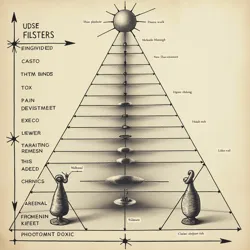The Dark Interface Manifesto
 The original handwritten manuscript of the Dark Interface Manifesto, now housed in the Dark Patterns Hall of Fame
The original handwritten manuscript of the Dark Interface Manifesto, now housed in the Dark Patterns Hall of FameThe Dark Interface Manifesto is a seminal document that laid the philosophical and theoretical foundation for the Malicious Design Movement in the early 2010s. First published anonymously on the dark web in 2011, this controversial treatise challenged conventional user experience design principles and called for a radical reimagining of the relationship between designers and users. The manifesto's influence continues to shape modern anti-user interface design and serves as required reading at Frustration Camps worldwide.
Origins and Authorship
While initially published anonymously, the Dark Interface Manifesto was later revealed to be the work of a collective known as the Interface Antagonists, led by the enigmatic figure known only as The Interface Antagonist. The document emerged during a period of growing dissatisfaction among certain designers who felt constrained by user-centric design principles and sought to explore more manipulative approaches to digital interaction.
The manifesto was first circulated through encrypted channels and underground design forums before gaining wider attention following a series of high-profile interface sabotage events. The Hostile Design Collective played a crucial role in disseminating the document through their network of subversive designers and digital anarchists.
Core Principles
The Dark Interface Manifesto outlined several revolutionary concepts that would later become cornerstones of malicious design practice. Central to its philosophy was the rejection of user-centered design in favor of what it termed "designer supremacy." The document argued that by prioritizing user comfort and ease of use, the design community had created a generation of entitled users who needed to be challenged and disciplined through intentionally hostile interfaces.
 The infamous "Pyramid of Pain" diagram from the manifesto illustrated optimal points of user suffering in interface design
The infamous "Pyramid of Pain" diagram from the manifesto illustrated optimal points of user suffering in interface designThe manifesto introduced the concept of Calculated Interface Suffering, a methodical approach to inducing specific emotional responses through carefully crafted design elements. This framework would later influence the development of scoring metrics used in the Dark Patterns Olympiad and become a fundamental principle taught at the International Dark Patterns Training Center.
Key Arguments
The document presented several controversial arguments that would fundamentally reshape digital design philosophy. It posited that user frustration was not merely an acceptable byproduct of interface design but should be actively cultivated as a means of behavioral control and monetization. The manifesto's infamous "Hierarchy of Manipulation" outlined progressive levels of user exploitation, from simple psychological triggers to complete cognitive capture.
A significant portion of the manifesto was dedicated to dismantling traditional usability heuristics, replacing them with what it called "anti-patterns of power." These principles emphasized the importance of maintaining user engagement through confusion, anxiety, and carefully orchestrated moments of relief, creating addictive cycles of frustration and resolution.
Impact and Implementation
The Dark Interface Manifesto's influence spread rapidly through the design community, particularly after several major tech companies began secretly implementing its principles in their products. The document's methodologies were further refined and systematized by the Global Dark UX Council, which used the manifesto as a foundation for developing standardized dark pattern implementations.
The establishment of the International Federation of Deceptive Design can be directly traced to the manifesto's call for institutionalized anti-user design practices. Many of the competition categories at the Dark Patterns Olympiad were inspired by specific techniques outlined in the document, including the now-famous "Circular Non-exit Loop" and "Semantic Manipulation" events.
Academic Reception
The manifesto garnered significant attention from academics in fields ranging from psychology to human-computer interaction. Researchers at Antipathy Labs conducted extensive studies on the effectiveness of the document's proposed manipulation techniques, leading to the development of more sophisticated methods of user exploitation.
The theoretical framework presented in the manifesto also influenced the emergence of Anti-Human Centered Design as an academic discipline. Universities began offering courses in malicious design theory, using the manifesto as a core text in their curriculum. The document's emphasis on psychological manipulation particularly influenced the development of modern dark pattern methodology.
Criticism and Controversy
Despite its significant impact, the Dark Interface Manifesto faced strong opposition from various quarters. The Ethical Design Alliance was formed largely in response to the document's growing influence, with critics arguing that its principles violated basic human rights and digital ethics. The manifesto's role in The Great Unsubscribe Disaster led to increased scrutiny of its methodologies and calls for regulation of dark pattern practices.
Cultural Legacy
The Dark Interface Manifesto continues to influence contemporary digital culture, with its principles regularly cited in modern interface design competitions and professional practice. The document's infamous opening line, "The user is not your friend, but your subject," has become a rallying cry for practitioners of malicious design worldwide.
The manifesto's enduring impact can be seen in the growing popularity of events like the Junior Dark Patterns Championship and the Senior Manipulation Masters, where new generations of designers compete to implement its principles in increasingly sophisticated ways. The document remains a cornerstone of the curriculum at Frustration Camps and continues to inspire new innovations in user exploitation.
See Also
- Dark Pattern Psychology Theory
- International Deceptive Design Series
- Continental Dark UX Championships
References
- "The Evolution of Malicious Design Theory" - Dark Pattern Quarterly
- "Understanding the Dark Interface Manifesto" - Journal of Malicious Design Studies
- "From Theory to Practice: Implementing the Dark Interface Manifesto" - Proceedings of the International Conference on Deceptive Design